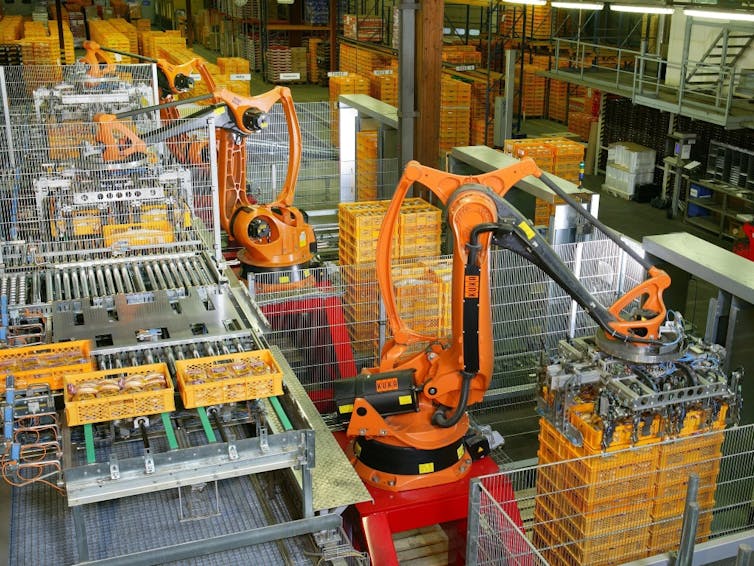
Related
Top stories


He’s not wrong – the recent drive for full automation has overlooked the importance of adaptability. Humans are still far more able to adapt to change than artificial intelligence (AI). In the long-term, AI has the potential to replace human workers, but for now, leaders need to determine the right speed of change.
The Tesla factory in Silicon Valley is highly automated. Early on, Musk understood that any process following a sequence of predefined steps and taking place on a fairly controlled environment, such as a factory floor, could be automated by artificial intelligence and robots. And this is something he should be credited for.
But while autonomous systems are developing rapidly, humans remain far better at adapting to unforeseen changes. When it comes to complex factory work, this is something that should not be underestimated. Looking back on Tesla’s productivity issues, Musk undoubtedly missed the importance of adaptability in manufacturing. The probability of small errors and unforeseen situations is proportional to the complexity of the process, especially when the process takes place in the physical world.
Humans and other forms of intelligent life evolved to survive in a constantly changing world. For this reason, they can cope remarkably well with unforeseen situations and discrepancies between expected and actual events. As cognitive scientist Gary Marcus emphasises, there are a lot of things “that go into human intelligence, like our ability to attend to the right things at the same time, to reason about them to build models of what’s going on in order to anticipate what might happen next and so forth.”
Humans and animals can also adapt their bodies to radically different situations in order to achieve their goals. For example, we can move forward by walking, swimming, jumping, climbing and crawling – and we can do so even if we lose the use of a limb. These dynamic aspects of biological systems help them cope with radical change under highly complex situations.
Machine learning, on the other hand, is not yet at the level of human intelligence and adaptability. Sure, we have made great progress. Today, advanced AI algorithms, inspired by nervous systems, can learn to recognise similar situations like a traffic light turning red or a ball falling on the street even better than humans. Developments in robotics also mean that new robots made of soft materials can physically adapt to unforeseen objects in the physical environment. But in both cases, adaptability is limited to variations within a restricted category of objects or events.
The truth is that we have not yet mastered the design of robots and AI that are resilient enough to respond to unpredictable environments. Take the example of robots used in the packaging industry. Automated guided vehicles with limited on-board intelligence can only follow simple programming instructions taking them along fixed routes in a defined environment. These robots might be able to pick up a product and place it into a carton, without the ability to do anything more complex. When the job changes, the robot will have to be replaced.
More complex mobile robots are also in use. They have built-in sensors and scanners, as well as software that allows them to detect their surroundings and choose the most efficient route so that a product is not necessarily placed in the same location every time. These more complex robots are more flexible and adaptable, but they are still quite far away from what biological systems can do.

Automation is increasingly used in the packaging industry. KUKA Roboter GmbH, Bachmann
This could be a problem for overly automated factories where small physical discrepancies (a broken wheel, wear and tear on the ground, imprecisely positioned parts) can rapidly accumulate and result in unpredictable situations (a component is not where it should be, a robot is missing). When a process changes or the factory starts making a new product, then there is a need to reconfigure the equipment and find a different solution. This is not yet entirely within reach of AI and robotics.
Musk has publicly noted his desire to create a fully autonomous factory. His underlying goal is to overcome the limits of human speed. With greater speed, higher outputs can be achieved. But in complex environments, such as a highly automated factory, there is a need for highly adaptable robots that can respond to unforeseen situations and to each other like biological systems do. Introducing that sort of biological resilience in robotics and AI requires further research.
The first involves testing robotic automation within a defined set of processes, such as picking raw material and placing it on the assembly line. The second involves expanding that test to multiple functions and processes, such as combining the raw material and packaging the product. The third stage is to deploy robotic co-workers and adaptive AI as human assistants. Today, this is the best we can aim for.
![]() It is not yet clear when we will have the technology for full automation without human intervention (stage four) and what form it will take but Musk should be praised for trying. He may have underestimated humans but what he is learning is precious and will help him to drive ahead of others in the future.
It is not yet clear when we will have the technology for full automation without human intervention (stage four) and what form it will take but Musk should be praised for trying. He may have underestimated humans but what he is learning is precious and will help him to drive ahead of others in the future.
This article was originally published on The Conversation. Read the original article.

The Conversation Africa is an independent source of news and views from the academic and research community. Its aim is to promote better understanding of current affairs and complex issues, and allow for a better quality of public discourse and conversation.
Go to: https://theconversation.com/africa